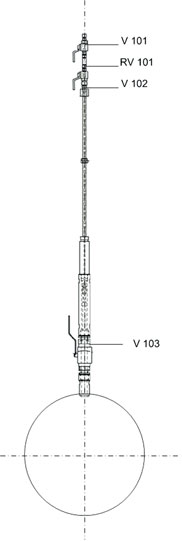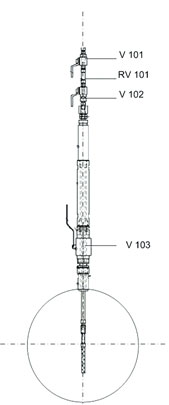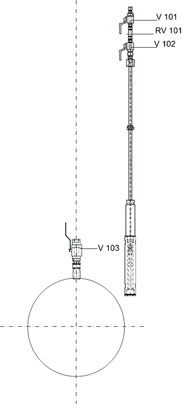In accordance with worksheet G 280 of the DVGW, gases supplied using public lines must have an adequate warning odor added to them so that it is evident whenever they are leaking. In 2018, a new version of the G 280 worksheet will become effective, enacting stricter rules which state that the evaporator at the odorizing system injection point must now also undergo maintenance every four years. In order to carry out these tasks, the complete injection nozzle must be removed, which previously required a great deal of on-site work. That is why LEWA GmbH developed a removable injection nozzle, which made its public debut at this year’s GAT/WAT trade fair in Cologne. The mechanism reduces the inspection time for the evaporator to an extremely short time span. This speeds up the entire maintenance procedure considerably. The system can even be retrofitted in existing systems.

Figure 1 shows the injection point in an installed and retracted state (source: LEWA).
“The transported natural gas must contain a sufficient warning odor to make sure that leaky home installations or accidental gas leaks are detected quickly and safely,” explains Walter Richter, sales manager for gas odorization and distribution at LEWA GmbH. “This is done by feeding an odorant through a special pipe into the respective gas line using an injection nozzle.”
Up to this point, yearly maintenance has been a requirement for such odorizing systems. However, an update to the DVGW worksheet G 280 now also requires the evaporator to be subjected to an inspection every four years. This was not a requirement previously. To simplify maintenance work, LEWA GmbH developed a removable injection nozzle with a removable evaporator end piece.
MAINTENANCE REQUIREMENT FOR THE GAS PRESSURE REGULATION STATION
Gas typically reaches the gas pressure regulation station with a high pressure of about 60 to 70 bar, and is then adjusted down to 4 to 16 bar. Here, the injection point for introducing the odorant is placed upstream of the last valve stop of the respective system. This is where the odorant is converted from a liquid to a gas by the evaporator and is then carried away by the gas flowing through the line. If the injection nozzle is not regularly maintained, crust and deposits may form due to the reaction of the substance accompanying the gas with the odorant. As a result, the available evaporation surface becomes smaller.

Figure 2 depicts the operating state.
The problem is that the felt located in the evaporator for dispensing the odorant requires the largest evaporation surface possible. If this surface is no longer available, the agent drips into the pipe and is prevented from odorizing the flowing gas optimally.
“The maintenance of this area has been somewhat neglected in recent decades, resulting in some odorant being wasted,” says Richter. “This is because the reduction of the surface has often completely prevented the evaporator from emitting the odorant that is added.”
NEW DESIGN WITH REMOVABLE EVAPORATOR SHORTENS MAINTENANCE WORK
The amendment to the DVGW worksheet G 280 also addresses this issue in order to avoid this problem in the future through more frequent maintenance, especially for the evaporator. However, this component can only be removed in a depressurized state. While it is possible to complete the task using a bypass, doing so would make the process more complicated due to the amount of space needed.

Figure 3 shows the device after removal. Now, the evaporator can be examined and replaced if necessary (source: LEWA).
“Our removable injection nozzle now provides an outstandingly efficient alternative,” explains Richter. “It consists of a dip stick tube with a large evaporation surface, a shut-off fitting and a check valve. Furthermore, the evaporator was designed to be removable to enable faster and easier replacement.”
The injection nozzle with a removable mechanism was presented at this year’s GAT/WAT in Cologne together with a fully equipped service vehicle.
About The Author
Roy Heinz is coordinator of service center for gas odorization at LEWA. LEWA GmbH was founded as a family company by Herbert Ott and Rudolf Schestag in 1952. Today, it is the world’s leading manufacturer of metering pumps and process diaphragm pumps as well as complete metering packages for process engineering. The Leonberg, Germany, based company developed into an international Group within a few decades and saw further improvement in its position on the world market as part of integration into the Japanese Nikkiso Co. Ltd. in 2009. As a research and production-oriented company, LEWA develops technologies and provides solutions for the vast array of applications among its customers. Its products are used mainly in the oil and gas industry, in gas odorization, in refineries and petrochemicals, as well as in the production of plastics, detergents, and cleaners. Additional application areas include the chemical industry, cosmetics industry, pharmaceuticals and biotechnology, food and beverage industry, and energy utilities. LEWA currently employs around 1,100 people and owns sixteen subsidiaries around the world along with having eighty representatives and sales offices in more than eighty countries. For more information, visit www.lewa.com.
_______________________________________________________
MODERN PUMPING TODAY, December 2017
Did you enjoy this article?
Subscribe to the FREE Digital Edition of Modern Pumping Today Magazine!



